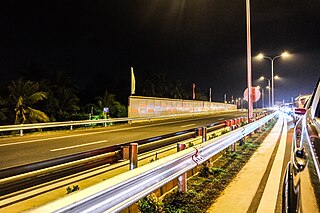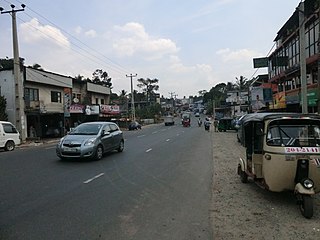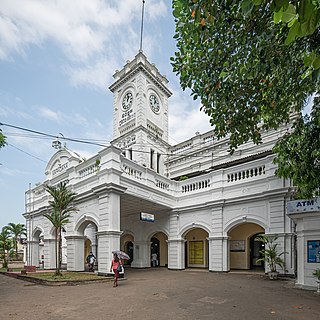
Transport in Sri Lanka is based on its road network, which is centred on the country's commercial capital Colombo. A rail network handles a portion of Sri Lanka's transport needs. There are navigable waterways, harbours and three international airports: in Katunayake, 35 kilometres (22 mi) north of Colombo, in Hambantota, and in Jaffna.

Nugegoda is a large, densely populated suburb of Colombo, Sri Lanka. It is located in the border of Sri Jayawardenapura Municipal Council limits and Dehiwela Mt. Lavinia Municipal Council limits, just outside Colombo city limits. It has a population of roughly over 250,000 people
Homagama is a town in the Colombo District, Sri Lanka, about 24 kilometres (15 mi) south-east of Colombo. The Homagama Pradeshiya Sabha consists of the Homagama divisional secretariat and 10 GN division of Padukka DS division. The total Land area is about is 137 square kilometres (53 sq mi) of 90 GN division. The Pradeshiya Sabha was established under act No 15 of 1987, and has the highest population of any pradeshiya sabha area in Sri Lanka. It is home to notable places, such as the campus of the National School of Business Management, Sri Lanka Institute of Nanotechnology, the Panagoda Cantonment, Upali Newspapers, Mahinda Rajapaksha College Homagama, St. Michael's College, Homagama, Buddhist and Pali University of Sri Lanka, Ceylon Biscuits Limited and the Laxapana Battery Company.
Maharagama is an outer suburb of Colombo, Sri Lanka on the High-Level (A4) Road about 10 km (6.2 mi) from the centre of the commercial capital. It developed rapidly in the 1980s as a dormitory suburb. Governed by the Maharagama Urban Council, the town possesses facilities like supermarkets, department stores, clothing, food and beverages shops to fulfill the needs of citizens.

The Sri Lanka Railway Department is Sri Lanka's railway owner and primary operator. As part of the Sri Lankan government, it is overseen by the Ministry of Transport. Founded in 1858 as the Ceylon Government Railway, it operates the nation's railways and links Colombo with other population centres and tourist destinations.
Avissawella, is a township in Sri Lanka, governed by an Urban Council, situated on the A4 route from Colombo to Ratnapura, Colombo District, Western Province, Sri Lanka, approximately 40 km air distance and 48.1 km road distance from east of capital Colombo. It is also known as Seethawakapura.
Pannipitiya is a suburb of Colombo. It is an area in Colombo District, Sri Lanka and is located about 15 km (9.3 mi) from the commercial capital. Pannipitiya is subdivided into a number of smaller areas.

Kottawa is one of the main suburbs in Colombo, Sri Lanka and is administered by the Maharagama Urban Council. It is located 21 km (13 mi) from the centre of Colombo. It is a five-way junction and lies as the epicenter for Maharagama road, Homagama road, Piliyandala road, Malabe road and Borella road.

The A4 Highway also known as the Colombo-Batticaloa highway, is the longest highway in Sri Lanka, at 430 kilometres (270 mi) in length. It connects Colombo with Batticaloa, through many important cities in Western, Sabaragamuwa, Uva and Eastern provinces.
Godagama is a town close to city of Colombo Sri Lanka. It is located in Colombo District within the Western Province, Sri Lanka.

Locomotives and train sets of Sri Lanka Railways consist mostly of diesel locomotives and multiple units. Steam locomotives are no longer used, except on heritage trains, such as the Viceroy Special.

Maradana Railway Station is a major rail hub in Colombo, Sri Lanka. The station is served by Sri Lanka Railways, with many inter-city and commuter trains entering each day. It is the terminus of several intercity trains.

The Batticaloa line is a railway line in Sri Lanka. Branching off the Northern line at Maho Junction, the line heads east through North Central Province and south-easterly through Eastern Province before terminating at the eastern city of Batticaloa. The line is 212 kilometres (132 mi) long and has 31 stations. The line opened in 1928. There were no services on the Polonnaruwa-Batticaloa stretch of the line between 31 October 1996 and 12 April 2003 due to the civil war. The Udaya Devi service operates on the line.

The Main Line is a major railway line in the rail network of Sri Lanka and considered by many to be one of the most scenic train journeys in all of Asia. The line begins at Colombo Fort and winds through the Sri Lankan hill country to reach Badulla.

The coastal line is a major railway line in Sri Lanka, running between Colombo Fort and Beliatta, via Galle and Matara. Operated by Sri Lanka Railways, the line includes some of the busiest rail services in the country. The line has been extended to Beliatta on 8 April 2019 and is proposed to be extended to Kataragama, via Hambantota. With a designed maximum speed of 100 km/h (62 mph) between Kalutara and Matara, and a maximum speed of 120 km/h (75 mph) between Matara and Beliatta, the line is one of the fastest in Sri Lanka.
Kottawa Railway Station is a railway station near Kottawa, Sri Lanka, which is a suburb city of Colombo. This station serves the Kaleni Valley Line and services are provided by Sri Lanka Railways.

Class S12 is a diesel multiple-unit (DMU), built for Sri Lanka Railways by China's CSR Corporation. The first batch arrived in Sri Lanka in August 2012. They were built to replace locomotive-hauled passenger trains. Seven of the S12 DMUs were ordered to strengthen long-distance travel on the Main line from Colombo to Badulla. Four of S12s will serve the Kelani Valley Line. The remaining two designed as luxury trains.

Class S8 is a Diesel multiple unit (DMU) made by Hitachi and Hyundai, operated by Sri Lanka Railways. It was imported to Sri Lanka in 1991 and, according to the website Sri Lanka Railways Info Page, is "the best diesel multiple unit ever imported to Sri Lanka".

















